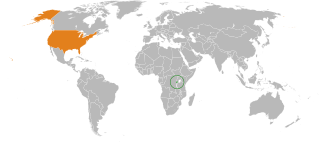
The United States President's Emergency Plan For AIDS Relief (PEPFAR) is the global health funding by the United States to address the global HIV/AIDS epidemic and help save the lives of those suffering from the disease. The U.S. allocation of over $110 billion marks the largest investment by any country has ever made towards combating a single disease. Launched by U.S. President George W. Bush in 2003, as of May 2020, PEPFAR has provided cumulative funding for HIV/AIDS treatment, prevention, and research since its inception, making it the largest global health program focused on a single disease in history until the COVID-19 pandemic. PEPFAR is implemented by a combination of U.S. government agencies in over 50 countries and overseen by the Global AIDS Coordinator at the United States Department of State. As of 2023, PEPFAR has saved over 25 million lives, primarily in sub-Saharan Africa.
Haiti—an island country 600 miles off the coast of the U.S. state of Florida—shares the Caribbean island of Hispaniola with the Dominican Republic. Haiti has received billions in foreign assistance, yet persists as one of the poorest countries and has the lowest human development index in the Americas. There have been more than 15 natural disasters since 2001 including tropical storms, flooding, earthquakes and hurricanes. The international donor community classifies Haiti as a fragile state. Haiti is also considered a post-conflict state—one emerging from a recent coup d'état and civil war.

Ivory Coast is one of the most pro-United States nations in Africa and the world, with 85% viewing the U.S. favorably in 2002, and rising to a high of 88% in 2007.

Ghana–United States relations are the diplomatic relations between Ghana and United States.

The United States established diplomatic relations with Malawi in 1964 after Malawi gained independence from the United Kingdom. Malawi's transition from a one-party state to a multi-party democracy significantly strengthened the already cordial U.S. relationship with Malawi. Significant numbers of Malawians study in the United States. The United States has an active Peace Corps program, Centers for Disease Control and Prevention, Department of Health and Human Services, and an Agency for International Development (USAID) mission in Malawi. Both countries have a common history and English language, as they were part of the British Empire.

Benin and the United States have had an excellent history of relations in the years since Benin embraced democracy. The U.S. Government continues to assist Benin with the improvement of living standards that are key to the ultimate success of Benin's experiment with democratic government and economic liberalization, and are consistent with U.S. values and national interest in reducing poverty and promoting growth. The bulk of the U.S. effort in support of consolidating democracy in Benin is focused on long-term human resource development through U.S. Agency for International Development (USAID) programs.

Botswana–United States relations are the bilateral relations between Botswana and the United States.

Relations between Burkina Faso and the United States are good, but has been subject to strains in the past because of the Compaoré government's past involvement in arms trading and other sanctions-breaking activity.

Cameroon–United States relations are international relations between Cameroon and the United States.

Guinea – United States relations are bilateral relations between Guinea and the United States.

Jamaica and the United States maintain productive diplomatic relations.

The United States and North Macedonia enjoy excellent bilateral relations.

Mozambique – United States relations are bilateral relations between Mozambique and the United States.

Rwanda–United States relations are bilateral relations between Rwanda and the United States.

Senegal–United States relations are bilateral relations between Senegal and the United States.

Eswatini–United States relations are bilateral relations between Eswatini and the United States.

Togo–United States relations are bilateral relations between Togo and the United States.

Uganda – United States relations are bilateral diplomatic, economic, social and political relations between Uganda and the United States.

United States aid to Sudan has three key objectives: a definitive end to conflict, gross human rights abuses, and genocide in Darfur; implementation of the north–south Comprehensive Peace Agreement that results in a peaceful post-2011 Sudan, or an orderly path toward two separate and viable states at peace with each other; and ensuring that Sudan does not provide a safe haven for international terrorists. Sudan has experienced two civil wars since 1955, the second of which lasted 22 years. During this time, the U.S. was the largest provider of foreign aid to Sudan, largely focused on humanitarian aid through the U.S. Agency for International Development. Sudan is listed as the U.S. government's highest priority in Africa due to "its importance for counter-terrorism and regional stability, as well as the magnitude of human rights and humanitarian abuses" U.S. foreign aid to Sudan has begun to see some positive indicators of performance although critical reaction has said that aid to Sudan is neither strategic nor focused.

The Catholic Medical Mission Board (CMMB) is an international, faith-based NGO, providing long-term, co-operative medical and development aid to communities affected by poverty and healthcare issues. It was established in 1912 and officially registered in 1928. CMMB is headquartered in New York City, USA, and currently has country offices in Haiti, Kenya, Peru, South Sudan, and Zambia.




















